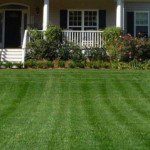Why Lime? Cause Its Time!
Fertilizers can’t do the whole job of keeping your lawn healthy and beautiful because they can’t raise the pH of acid soil. Poor lawns are often the result of acidic soil, especially when growing Fescue in our area. Lime is an excellent way to correct low soil pH, and Fall is the best time for liming your lawn because the soil expands and contracts as the temperature fluctuates during the winter months. This motion works the lime into the soil. Also, the increase of moisture during the fall and winter helps “percolate” the ground and coats the soil with lime particles.
Lime comes in three forms: pulverized, which is a fast-acting powder recommended for the garden; granular, which is sugar-textured and dust-free; and pelletized, which is fast-acting and dust free. Granular and pelletized forms can be applied to the lawn with a drop or rotary spreader. Application rates for the different types of soil are listed right on the back of the product bag. Generally, fifty pounds of lime per thousand square feet will raise the pH ½ of a point.
How do soils become acidic?
Over the years, calcium and magnesium, the alkaline components in the soil, become replaced by hydrogen and are lost in drainage water. Also, while nitrogen is essential for good growth of grass, heavy applications make the soil more acidic. Not only does lime correct the acidity of the soil by reducing the toxic amounts of aluminum, manganese and iron, but it also supplies calcium and magnesium, which are essential for plant growth. Other benefits of applying lime include less leaching of potassium, making phosphorus more available and speeding the decomposition of organic matter in the soil for reuse by the plant.
How can you find out if your soil is too acidic? For a complete analysis of your soil, contact the Clemson Extension Service.






